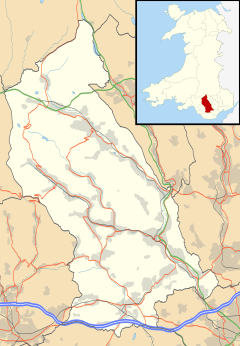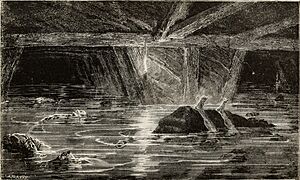Porth facts for kids
Quick facts for kids Porth |
|
|---|---|
 Rheola Bridge, Porth |
|
| Population | 5,970 (2011) |
| OS grid reference | ST025915 |
| Principal area |
|
| Ceremonial county | |
| Country | Wales |
| Sovereign state | United Kingdom |
| Post town | PORTH |
| Postcode district | CF39 |
| Dialling code | 01443 |
| Police | South Wales |
| Fire | South Wales |
| Ambulance | Welsh |
| EU Parliament | Wales |
| UK Parliament |
|
| Welsh Assembly |
|
Porth (Welsh: Y Porth) is a town in Wales. It is located in the Rhondda Cynon Taf area. Porth is in the historic county of Glamorgan.
The town sits in the Rhondda Valley. It is seen as a "gateway" because the Rhondda Fawr and Rhondda Fach valleys meet here. The Welsh word "porth" actually means "gate". Most people in Porth speak English.
Nearby villages include Trealaw, Trebanog, Trehafod, and Ynyshir.
Contents
Porth's History
Early Times
Long ago, the area where Porth is now was a forest. People lived higher up in the valley. Only stone piles, called cairns, were found in the Porth area. These were used as markers for paths.
During the Middle Ages, the area was part of Glynrhondda. But it was still mostly empty. There were no big buildings then. However, travelers used two bridges over the River Rhondda. These were Pont Rheola and Pont y Cymmer. They were mentioned in the 1530s. The bridges were first made of wood, then rebuilt with stone.
The first notable buildings were south of Porth, in a place now called Cymmer. These included a chapel and a mill. By the 1700s, there were a few farmhouses. The area was known as Cymmer, meaning "where two rivers meet". The name Porth came later, with coal mining and the railway station.
The Rise of Coal Mining
In 1809, Walter Coffin started the first coal mine in the Rhondda. It was in Dinas, further up the valley. But it was hard to move the coal without good transport. So, Coffin built a tramline. This line connected his mines to a canal that went to Cardiff. The tramline went right through Porth.
This made the Porth area good for mining. By the mid-1800s, more people wanted to mine coal there. In 1844, the first small coal mine opened in Porth. Then, in 1845, the Porth Colliery was built. Its success led to another mine, Llwyncelyn Colliery, in 1851. By 1850, the Taff Vale Railway reached Cymmer. This made it easier to get coal to the ports.
More mines opened, like Troedyrhiw Colliery and Tynewydd Colliery. Tynewydd Colliery opened in 1852. It quickly found a good coal seam. This led to more jobs, as ovens were built to make coke from the coal.
As more people moved to Porth, transport improved. Roads sometimes sank because of mining underground. In 1860, a bus service started between Porth and Pontypridd. Later, horse-drawn trams were used. Porth got its first railway station in 1861. Passenger trains started running in 1863.
Businesses grew as the population increased. Porth became a commercial center. A famous grocery chain, Thomas & Evans, opened a shop there. William Evans, one of the owners, was important to Porth's growth. He opened a jam factory and a mineral water factory. This factory later became Corona drinks. It was a major employer until the 1980s.
Coal mining kept growing in the early 1900s. But times became tough after the Great Depression. Many miners lost their jobs. The 1926 United Kingdom general strike made things worse. Older mines in the Rhondda couldn't keep up with new technology. They started to close one by one. Porth, like other towns in the Rhondda, depended on coal. When mining stopped, many people had to leave to find work.
During World War II, jobs increased. This was partly because Rhondda coal was needed. Also, large factories were built nearby for making weapons. After the war, the government helped bring new industries to the Rhondda. Porth got six new factories. These made things like boxes, metal toys, and provided jobs for disabled workers.
Tynewydd Colliery Disaster
On April 11, 1877, the Tynewydd Colliery had a terrible accident. Water from old mines nearby flooded the Tynewydd mine. About 100 miners worked there, but only 14 were underground at the time.
Four trapped miners were saved after 18 hours. But one miner, William Morgan, died. Four others drowned. Five more miners were trapped behind a thick wall of coal. There was a lot of water and air behind it. It took four days to cut through the wall.
On April 19, only a few yards were left. Work stopped because of the danger of the water bursting through. But four rescuers bravely volunteered to keep going. These included Daniel Thomas, Isaac Pride, John William Howell, and William Beith. Dangerous gas escaped, putting out their lamps. But they kept working in the dark.
On April 20, at 3:00 p.m., they broke through. Isaac Pride worked in a very small space. When his pick broke through, a blast of air pushed him back. But he quickly made the hole bigger with help from "Abby" Dodd. They found the five trapped miners too weak to stand. Pride and Dodd pulled them to safety as the water rose.
The Albert Medals for Lifesaving were given for this rescue. These were the first Albert Medals given for bravery on land. The medal was usually for rescues at sea. William Beith's medal can be seen at the National Museum of Wales in Cardiff. The mine doctor, Dr. Henry Naunton Davies, also received a special medal for his work.
Porth Today
Today, Porth's main economy is retail. The town center, especially around Hannah Street, is a shopping area. Other businesses are on Pontypridd Road and Porth Street.
About 6,000 people live in Porth. They live in areas like Birchgrove, Britannia, Glynfach, Llwyncelyn, Mount Pleasant, and the town center.
A crater on Mars is named "Porth" after the town!
Education in Porth
Children of secondary school age usually go to Porth County Community School. This school teaches in English. Some children attend Ysgol Gyfun Cwm Rhondda. This is a Welsh-speaking school in the Cymmer area of Porth.
Getting Around Porth
Porth railway station has train services. You can travel to Treherbert and Cardiff on the Rhondda Line. Transport for Wales runs these train services.
A new road, the Porth-Tylorstown bypass, opened in 2006. It helps traffic flow better. People had talked about building this bypass for over 50 years!
Fun and Sports in Porth
Porth is home to The Pop Factory. It opened in 2000. Famous singers like Tom Jones and Cerys Matthews attended the opening. It is a television and recording studio. The Pop Factory also helps the local area. They helped organize a concert for Tom Jones in Pontypridd in 2005.
Porth has a Welsh Rugby Union rugby club called Porth Harlequins.
Football Association of Wales affiliated A.F.C. Porth play their home matches at Dinas Park. Their base is the Wyndham Constitutional Club.
The South Wales Automobile Club (S.W.A.C.) is also in Porth. They organize the Welsh Rally. This car rally started in 1937. Many top international rally drivers have taken part over the years.
Famous People from Porth
- Margaret Bevan, a young evangelist, was born in Porth.
- Llew Edwards, a British featherweight boxing champion.
- J. Gwyn Griffiths, an Egyptologist, poet, and Welsh nationalist.
- Cliff Jones, a Wales international rugby captain.
- Percy Jones, a World Boxing Flyweight champion.
- David Lyn, a stage and television actor.
- Gwyn Thomas, a novelist.
- Dennis Claude Young, an RAF Squadron Leader during World War II.
Location Grid
 |
Ynyshir |  |
||
| Penygraig & Trealaw | PONTYPRIDD | |||
| Cymmer |
See also
 In Spanish: Porth para niños
In Spanish: Porth para niños



